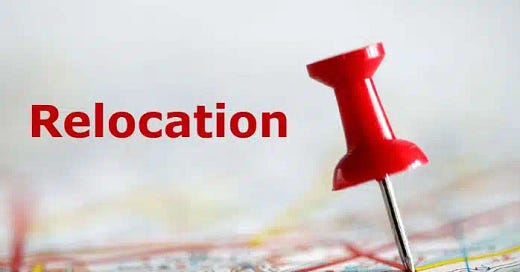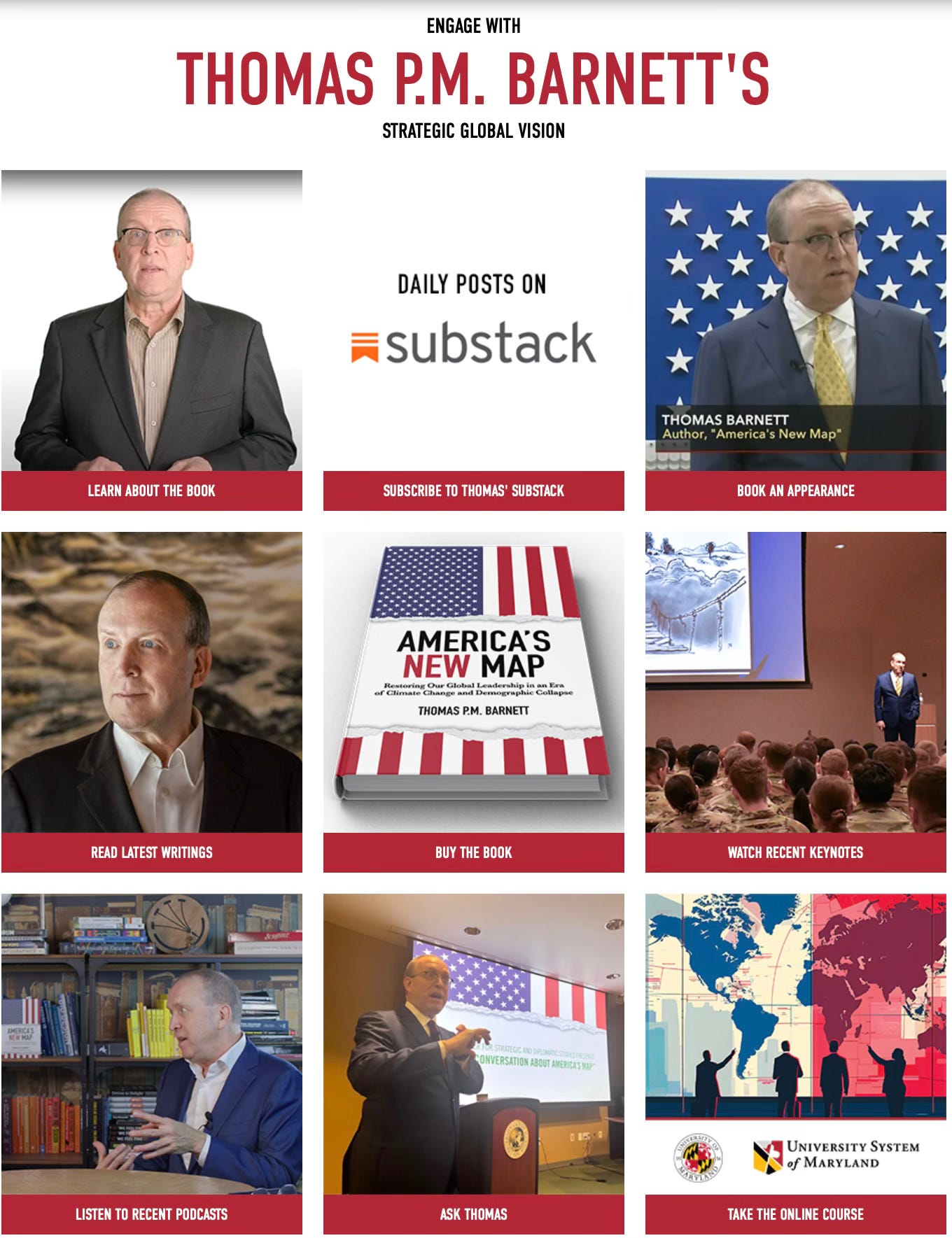A real-estate POTUS for a re-lo world
3 rules of real estate in this century are Re-location! Re-location! And re-location!
My long-time business partner and thought-collaborator Steve DeAngelis calls it the “relocation economy”:
Climate Change: The Relocation Economy
Climate change is no longer a distant challenge; it’s already reshaping where and how people live and work. Rising temperatures, melting ice caps and increasingly severe storms are forcing migrations. These population shifts could ripple across industries, impacting everything from real estate and infrastructure to global supply chains and talent availability.
For businesses, adapting to the “relocation economy” will require a twofold approach: mitigating risks and capitalizing on opportunities. Companies must rethink their product portfolios, raw material sourcing and physical footprints, investing in climate-resilient infrastructure and supply chains that can withstand disruptions. The businesses that embrace adaptability and invest in long-term resiliency will emerge as leaders in the climate-challenged economy.
That is no-nonsense advice, whatever your “feelings” are about climate change’s causality. Everything about your operating environment is being relocated by climate velocity — the long-term shifting of a clime across landscapes, regions, hemispheres, latitudes. Where you obtain materials, where you can grow food, where you can support urban development, where you can still live at reasonable risk, and — most saliently — when all of those answers get too tough for the locals, where they end up moving (you know, they, your customers!).
At first, people and businesses are going to view this challenge as a series of discrete decisions: Where do I get that crop this year? Where do I locate my factory or processing center now? And so on — discrete, somewhere-in-time decisions to be investigated, weighed, and made.
But, in truth, things are going to be so much more dynamic than that. We’ll all get used to making changes and shifts and quick little moves — on the fly as we experience more environmental whiplash effects of Extreme This followed immediately by Extreme That, only to be doubled-up by Extreme What-The-Hell-Was-That?
AI, in many ways, arrives just in time for those challenges. Per DeAngelis:
The question of the moment will be, “How do we control and coexist with a non-human intelligence that could surpass our own capabilities?” To adequately address issues like these, public and private leaders will need to be proactive. We will need to start engaging in conversations, determining the right questions to ask, building AI maturity models to help govern the use of AI in critical use cases, developing guardrails and exploring supplemental tools now if we are to navigate this complex new frontier responsibly.
Here’s where XAI (Explainable AI) comes in: establishing the trust and transparency needed for social, economic, and political acceptance — otherwise every AI overstep and F-up and disaster (and they will arrive regularly) will be met with constricting legislation forced into being by public anger.
DeAngelis:
These advanced AI agents will act like the autopilots of the business world, capable of augmenting humans by executing tasks with precision and reliability. For companies, the key will be balancing the push for innovation with the need for trust and accountability. The goal must be building AI systems that can be relied upon while remaining transparent with customers and in alignment with organizational goals.
AI will thus be branded like everything else and with everything else.
For example: DeepSeek seems to be the “discount” path to great AI, but, in reputational terms, it’s a real problem that a good portion of its Big Data feed contains significant amounts of Chinese Communist Party propaganda. The notion that AI is somehow totally separable from its sources is a myth, but that’s true of any intelligence, is it not?
We are not just how we learned but what we learned.
So, brand and reputation of AI will matter. Maybe we’ll see all these measures and labels and “proofs” to indicate the purity and source of the AI — not unlike whisky or wine or anything else where you want or need to feel comfortable (or even just desirous) of this style or brand or ethos versus another.
We’re not yet there but understand this: eventually religion will get all mixed up in AI (not before medicine, mind you, but soon after): people wanting the AI they use to reflect their spiritual values, which, and I’m just guessing here, the Tech Bros will not be able to make happen on their own — given their high tolerance for ambiguity and libertarian leanings.
AI will thus eventually become a fellow traveler of ideology: the great massing of all those values as a guide to a good life, good economy, good community, good nation, good world. In sum, the ethics of AI will naturally become the long pole in its tent, determining its strength and reach and power and acceptability.
But, back to my theme today: it is weirdly fitting that we have a real-estate president in the White House at this point in our history where we’re just waking up to this world being put into all manner of motion by climate change.
A great NYT piece recently by Lydia Polgreen (very much in the manner of my inspiration on this subject, the enviro journalist Gaia Vince):
We are living in an age of mass migration.
Millions of people from the poor world are trying to cross seas, forests, valleys and rivers, in search of safety, work and some kind of better future. About 281 million people now live outside the country in which they were born, a new peak of 3.6 percent of the global population according to the International Organization for Migration, and the number of people forced to leave their country because of conflict and disaster is at about 50 million — an all-time high. In the past decade alone, the number of refugees has tripled and the number of asylum seekers has more than quadrupled. Taken together, it is an extraordinary tide of human movement.
What should impress us right now are two things:
Just how much these migratory pressures have already altered politics across the Global North (Polgreen’s next point); and
The realization that we’re just at the beginning of this age, meaning the magnitude coming is likely beyond our imagination, thus resulting in warning-sign analyses like this.
Climate change will empty out the lower latitudes to a degree hard for us to fathom at this point in history.
Then we get to the “irony” Polgreen cites, which is why the subtitle of my book mentions both climate change and demographic collapse:
But these vituperative responses reveal a paradox at the heart of our era: The countries that malign migrants are, whether they recognize it or not, in quite serious need of new people. Country after country in the wealthy world is facing a top-heavy future, with millions of retirees and far too few workers to keep their economies and societies afloat. In the not-so-distant future, many countries will have too few people to sustain their current standard of living.
Both problem and solution are staring us in the face. Climate change forces mass migration while demographics welcomes it to a certain extent.
As Polgreen notes: south-to-north migration is inevitable and it will be profound, but here’s where we get to my superpower brand war concept:
“In this hyperpolarized environment and debate, many people have missed the big picture,” said Marco Tabellini, an economist who studies migration and political change at Harvard University. “Countries in the global north will have to really compete for migrants.”
We’ll compete in the North for the South’s migrants but we’ll also compete across that Global South to (a) keep as much of the local population resiliently in place (not everyone can move up North and realistically we cannot write off the lower latitudes) and (b) wire up and capture the brand loyalties of those in the Global South who remain there (that emergent majority global middle class of consumers).
In other words, the re-lo dynamic has to go both ways: the Global North needs to re-locate itself southward in terms of integration and membership and belonging because, without all that connectivity, the great, “fantastical” answer of walling ourselves off from all that opportunity and suffering will prevail to no good outcome.
And yeah, let’s be honest, the big driver of such integration schemes will be fear — as usual. At first, the fear will be about managing the flow (Trump’s already elevated that to a national cause), then it’ll be about keeping it from getting out of control (Trump won a second change to go there thanks to Biden blowing off the subject for the bulk of his term) , and then it will be about making your integration happen before those efforts of your competitors (the latest Trumpian focus on Chinese influence resulting in trade threats that scramble all manner of our relationships around the world). Ultimately it’ll be about which superpower brand do you, Country A of the lower latitudes, want to associate yourself with over time, leading to deeper and deeper economic and security and political integration —> belonging —> membership?
It’ll all come down to which superpowers brand handles scale and volatility best. DeAngelis poses that challenge today primarily in business terms, but it will extend to governmental terms over time, and that’s where Steve’s admonition about moving from the “black box” of today’s AI to the “glass box” of tomorrow’s Explainable AI (XAI) is so crucial.
For now, we seem to think it’s all about which AI can be achieved most cheaply in terms of resources, and, sure, reducing the environmental footprint is hugely important and natural and subject (for now, thank God) to intense international competition (good for all of us), but — stipulating all that progress in “manufacturing” AI, what will really matter down the road is its brand, quality, ethos, attractiveness, ideological and spiritual affinity, and so on, forcing a mass customization imperative upon an industry that never starts there (think, MS) but has shown great capacity to move there (think, Apple).
This is where, as I understand it, we move into “agentic AI” or AI that can operate on its own to perform tasks without human intervention. Sounds great, but it’s also a bit of an illusion: we won’t want AI agents in our daily lives that are insulated from our natural desires for intervention (i.e., shaping the performance of those agents to meet our particular tastes, beliefs, ethos, etc.).
On that point, see the current batch of AI-centric Matthew McConaughey commercials:
For humans to grow truly comfortable with agentic AI, we’ll need to feel like we “own” — in a very intimate manner — those individual agents we invite into our daily lives to act as our representatives to, and interlocutors with, that wider, increasingly cyber-ized world.
I know, it’s all so Black Mirror in tone up front, but it’ll work out because customers will demand that it works out.
Think of Luke Skywalker and his intimate relationship with R2D2: it can’t be just about performing tasks; it has to be about being on the same ethical page (or, in this case, same “force” vibe).
Again, for now, the race for AI seems to be all about technical achievements, and that’s natural. But as those technical achievements pile up, it’ll be more and more about whom do you trust? Especially in a world defined by relocation, which is inherently discombobulating and scary (again, look at what current immigration flows/pressures have ALREADY done to our political environment across the North).
MAGA America is excited to see Trump smash up a system they feels no longer works on their behalf in this world of ours (plenty of truth in that anger). For now, MAGA America has no idea what best replaces or improves that system; it just knows the current version isn’t working and feels alien.
The Tech Bros have jumped on the Trump train because it’s a going concern alright, promising all sorts of leeway in the near and medium term for them to push an agenda of systemic change — basically, updating our economics and politics to the information/AI age.
Both of these impulses are ultimately positive but double-edged, naturally. We can expect both to compliment each other when they can and combat one another on all sorts of issues that ultimately speak to the brand-comfort dynamic I describe above — without quite solving them.
Those broader solutions will come in a follow-on Progressive Era that, to date, neither the Dems or Republicans have been able to articulate — much less mount in our polarized and evenly divided electorate — and yeah, that is another great problem of our time.
We have not yet found our Roosevelts (Teddy and Franklin), but we eventually will.
Until then, a real-estate POTUS eager to build cities of tomorrow and add new stars to our flag … well, that’s a weird and uncomfortable progress for a lot of Americans even as it moves us in the right, general direction.
In short, we all work with what we have at the moment, so the trick for non-MAGA America is finding those points of concurrence with MAGA America as this bull-in-china-shop presidency unfolds.
I know a lot of people don’t want to hear that advice, but the stakes of this moment are too high for “resistance” to be mindlessly all-encompassing.
Remember: to be an effective commander, nice Jim Kirk still needed nasty Jim Kirk. The two, while separable in many ways, could not individually survive without the other.
My ultimate point: take every win, take every compromise, take every collaboration. Neither MAGA nor non-MAGA America cannot live without the other, because it is in the balancing of those instincts (market-making versus market-playing) that the true solutions will be found.










